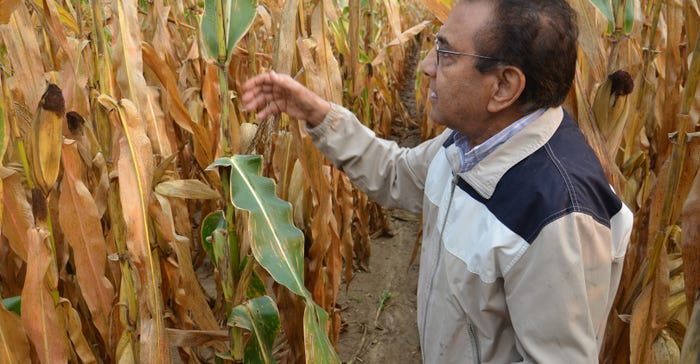
Any time you commit to scouting a field, any field, every week or even every other week for an entire season, you will find classic examples of many things. Maybe you’ll see disease symptoms, nutrient deficiency, super-long ears or stalk rot. What you find may depend upon the characteristics of the hybrids you’re scouting. The biggest determining factor will be weather and environmental conditions.
Dave Nanda, an independent crops consultant, says if it’s wet, you’re more likely to find nitrogen deficiency. If you’re scouting on low organic matter soils, you may find other deficiencies, including potassium deficiency. When the weather is wet and turns warm, gray leaf spot will likely show up. How much you see will depend upon when the disease starts, how resistant hybrids are, and whether or not the farmer applies fungicides.
Throw in cool weather and you may see northern corn leaf blight. Add in some Japanese beetles or corn rootworm beetles during silking, and you may see some silk clipping. If one or more hybrids don’t have resistance to European corn borer and moths fly into the area, you may find shot-hole feeding on leaves early. Then you may find more shot-hole feeding later in the season. You may even find a rootworm larva tunneling inside a stalk, or even inside an ear.
If dry weather sets in, stalks may be more susceptible to stalk rot. Some hybrids are more susceptible than others, Nanda says. When you do a simple push test while scouting late in the season, if a sizable number of stalks do not snap back when you push them over, that indicates stalk rot. If you look closer, you may find black specks on the outside of the stalk and discoloration inside. Those are signs of stalk rot, namely anthracnose stalk rot.
Whether or not these problems are enough to impact yield depends on how many plants are affected during the season, Nanda says. The point of scouting, though, he says, is to know what is in the field, diagnose it, and monitor it to see if it progresses. Maybe you can do something to help this year’s crop — maybe not. But if you know what’s in the field, you can make better-informed decisions for next season about which hybrids you plant where, how you fertilize for corn, when and how much nitrogen you apply, and how you control insects.
That’s the purpose of Corn Watch ’17. It’s sponsored by Seed Genetics-Direct, Washington Court House, Ohio.
Take a look at these examples of various things Nanda found while scouting the Corn Watch ’17 field regularly this season. Despite some of what he found, he still expects good yields. Look for those reports soon.
About the Author(s)
You May Also Like




